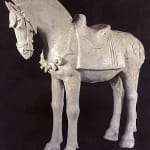Sui Glazed Terracotta Sculpture of a Horse, 581 CE - 618 CE
Glazed Terracotta
height 34.3 cm
height 13 1/2 in
height 13 1/2 in
H.530
After almost four hundred years of civil war and division, Yang Jian succeeded in reunifying north and south under one authority, the Sui Dynasty. However, despite its brief duration, lasting...
After almost four hundred years of civil war and division, Yang Jian succeeded in reunifying north and south under one authority, the Sui Dynasty. However, despite its brief duration, lasting for the rule of only two emperors, the Sui Dynasty paved the way for the cultural renaissance that would arise during the T’ang Dynasty. Reforms were introduced to wrest power out of the hands of the aristocracy, military, and Buddhist communities. The Confucianist system of selecting government officials from state schools, by means of rigorous examinations, was initiated. Perhaps their most significant program was the construction of the Great Canal, a project that facilitated the movement of people and goods across great distances, aiding in the reunification of China. However, the cost of the Canal bankrupted the empire and ultimately led to its dissolution, coupled with a failed campaign to conquer Korea. The rulers of the T’ang would capitalize on the infrastructure improvements of the Sui and establish one of the greatest empires in the history of China, following the footsteps of the Sui.
An emblem of speed and perseverance, the horse has always served a special role in Chinese life. This Sui representation attests to horse as a symbol of wealth and status among the aristocratic classes. Its long slender legs, hogged mane, streamline body and decorative saddle and bridle give it an air of prestige and elegance unsurpassed by earlier representations which emphasized brute force through a blockish body line. Its powerfully rounded neck, muscular throat-latch, and tuff of hair reaching between its standing ears enhance its confidence and serene composure. The details of its gear--studded bridle and leather straps of imperial regalia--indicate its use in ceremonial processions. After the unification of the empire under the Sui, tomb figurines came to reflect the sophisticated world of wealthy nobles from the north, accustomed to foreign contact, travel, and a luxurious lifestyle in the capital city as the tomb became a powerful political instrument to reinforce the might of the central government. Thus the underlying theme became status and mobility. Replacing the ox cart as a means to transport the deceased to the other world, a saddled horse occupied a privilege position in close proximity to the coffin or tomb tablet. This figurine of a horse not only reflects the artistic sensibilities and beliefs of the early Chinese, but contains the energy of the horse whose honorable duty was to facilitate the journey into the other world.
An emblem of speed and perseverance, the horse has always served a special role in Chinese life. This Sui representation attests to horse as a symbol of wealth and status among the aristocratic classes. Its long slender legs, hogged mane, streamline body and decorative saddle and bridle give it an air of prestige and elegance unsurpassed by earlier representations which emphasized brute force through a blockish body line. Its powerfully rounded neck, muscular throat-latch, and tuff of hair reaching between its standing ears enhance its confidence and serene composure. The details of its gear--studded bridle and leather straps of imperial regalia--indicate its use in ceremonial processions. After the unification of the empire under the Sui, tomb figurines came to reflect the sophisticated world of wealthy nobles from the north, accustomed to foreign contact, travel, and a luxurious lifestyle in the capital city as the tomb became a powerful political instrument to reinforce the might of the central government. Thus the underlying theme became status and mobility. Replacing the ox cart as a means to transport the deceased to the other world, a saddled horse occupied a privilege position in close proximity to the coffin or tomb tablet. This figurine of a horse not only reflects the artistic sensibilities and beliefs of the early Chinese, but contains the energy of the horse whose honorable duty was to facilitate the journey into the other world.
Literature
V17



